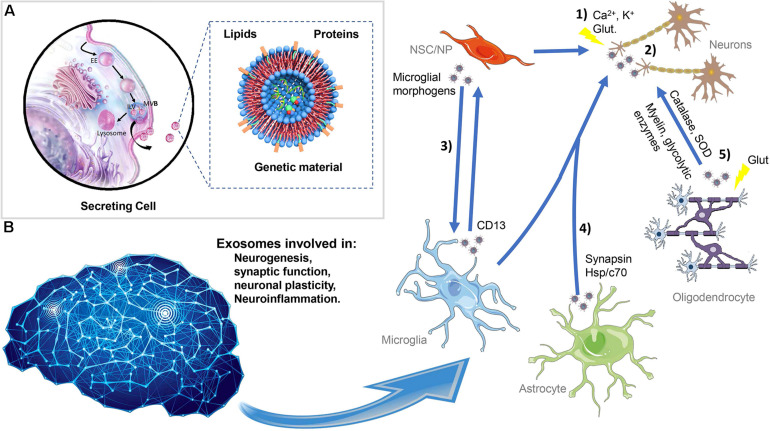FIGURE 2.
Exosome biogenesis, secretion, and interaction in the central nervous system. (A) Exosomes originated in the endocytic pathway as ILVs resulting in the formation of LE with multiple small vesicles termed MVBs. During this process, exosomes are loaded with proteins, lipids, and genetic material. Afterward, the MVBs can be destined for lysosomal degradation or fused with the plasma membrane and the exosomes released into the extracellular space. The exosomes have a complex composition of proteins such as ALIX, TSG101 and flotillin, Rab family, tetraspanins (e.g., CD63, CD81, and CD9), mitochondrial proteins, and others; lipids including cholesterol, sphingomyelin, glycosphingolipids, and ceramide; and nucleic acids especially RNA and also nuclear and mitochondrial DNA. (B) Exosomes can be released from NSC/NP, neurons, astrocytes, oligodendrocytes, and microglia acting in proximal or distal cells. Exosomes can be shuttled between the different neural cells modulating distinct neuronal processes such as neurogenesis, synaptic function, neuronal plasticity, and neuroinflammation. (1) In neurons, exosomes are released in response to stimulus, such as calcium influx, glutamatergic synaptic activity, and potassium-induced depolarization. (2) The exosome signaling pathways include neuron-to-neuron communication. (3) NSC can influence the microglia function, and exosomes released from glial cells exert effects on NSC. (4) Additionally, exosomes originated in astrocytes can be fundamental for the trophic support of neurons. (5) Oligodendrocytes can also shuttle to neuron exosomes containing myelin proteins and glycolytic enzymes. ILVs, intraluminal vesicles; EEs, early endosomes; MVBs, multivesicular bodies, NSC/NP, neural stem/progenitor cells.

